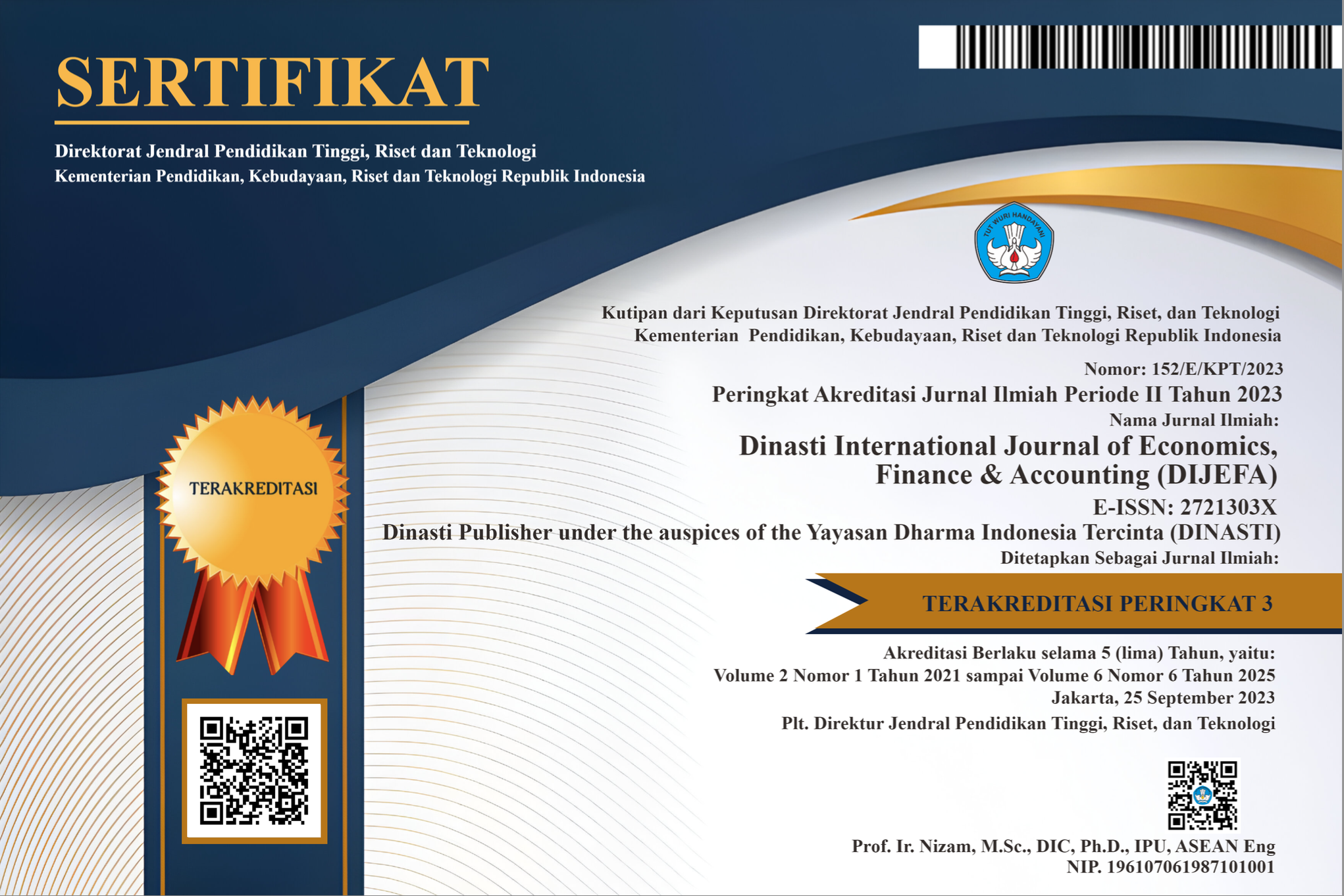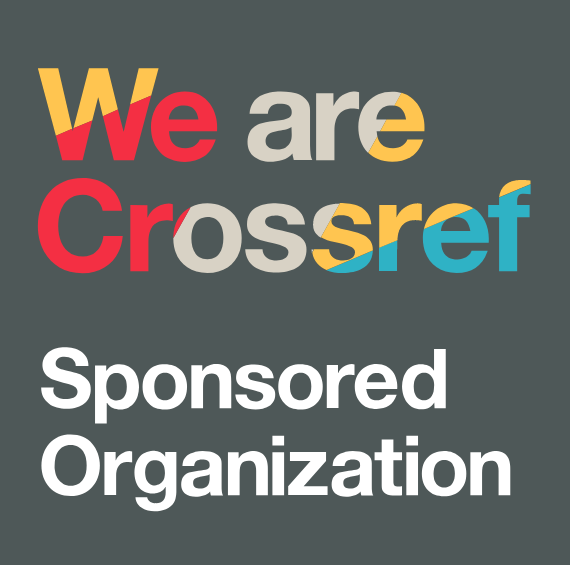Fraud Pentagon Theory for Detection of Fraudulent Financial Reports: A Preliminary Study in Manufacturing Enterprises in Indonesia
DOI:
https://doi.org/10.38035/dijefa.v5i5.3490Keywords:
fraudulent financial statement, consumer goods, detection of financial fraudAbstract
The study aims to test whether the five elements of the Fraud Pentagon are useful in detecting fraud in financial reports. These five elements require proxy variables for analysis and cannot be directly measured. Pressure is measured through external pressure. The nature of industry can be used to measure opportunity. Rationalization is measured by AUDCHANGE. Capability is measured through DCHANGE. Arrogance is measured through the CEO's picture. 23 manufacturing enterprises in the consumer goods category on the IDX were included in the study sample for the 2019–2022 period. The research samples consist of financial statements and annual reports as secondary data. The data was analyzed using logistic regression, and the samples were chosen through purposive sampling. Results showed the significant impact of opportunity, pressure, rationalization, and arrogance on financial report fraud. And for the variable of capability, it showed that it has no effect on fraudulent financial statements.
References
Achmad, T., Ghozali, I., & Pamungkas, I. D. (2022). Hexagon fraud: Detection of fraudulent financial reporting in state-owned enterprises Indonesia. Economies, 10(1), 13.
Afjal, M., Salamzadeh, A., & Dana, L. P. (2023). Financial fraud and credit risk: Illicit practices and their impact on banking stability. Journal of Risk and Financial Management, 16(9), 1–30. https://doi.org/10.3390/jrfm16090386
Agustina, R. D., & Pratomo, D. (2019). Pengaruh Fraud Pentagon dalam mendeteksi kecurangan pelaporan keuangan. Jurnal Ilmiah MEA (Manajemen, Ekonomi, & Akuntansi), 3(1), 44–62. https://doi.org/10.31955/mea.vol3.iss1.pp44-62
Aprilia, S. R. N. A., & Furqani, A. (2021). Deteksi kecurangan laporan keuangan dengan metode fraud diamond pada perusahaan jasa. Journal of Accounting and Financial Issue (JAFIS), 2(2), 1–11. https://doi.org/10.24929/jafis.v2i2.1661
Beasley, M. S. (1996). An empirical analysis of the relation between the board of director composition and financial statement fraud. Accounting Review, 71(4), 443–465.
Bengtsson, M., & Kock, S. (2000). “Coopetition” in business networks - To cooperate and compete simultaneously. Industrial Marketing Management, 29(5), 411–426. https://doi.org/10.1016/S0019-8501(99)00067-X
Bornemann, T., Moosmann, A. L., & Novotny-Farkas, Z. (2023). The Consequences of Abandoning the Quarterly Reporting Mandate in the Prime Market Segment. European Accounting Review. https://doi.org/10.1080/09638180.2023.2239298
Bourveau, T., Chen, J. V., Elfers, F., & Pierk, J. (2023). Public peers, accounting comparability, and value relevance of private firms’ financial reporting. Review of Accounting Studies, 28(4), 2642–2676. https://doi.org/10.1007/s11142-022-09707-y
Dewi, K. C., & Yuliati, A. (2022). Pengaruh fraud hexagon terhadap kecurangan laporan keuangan: Studi empiris pada perusahaan makanan dan minuman yang terdaftar di BEI. Jurnal Riset Terapan Akuntansi, 6(2), 115–128. https://doi.org/10.5281/zenodo.7262498%20
Evana, E., Metalia, M., Mirfazli, E., Georgieva, D. V., & Sastrodiharjo, I. (2019). Business ethics in providing financial statements: The testing of fraud pentagon theory on the manufacturing sector in Indonesia. Business Ethics and Leadership, 3(3), 68–77. https://doi.org/10.21272/bel.3(3).68-77.2019
Faradiza, S. A. (2019). Fraud pentagon dan kecurangan laporan keuangan. EkBis: Jurnal Ekonomi Dan Bisnis, 2(1), 1. https://doi.org/10.14421/ekbis.2018.2.1.1060
Grewal, J., Mohan, A., & Pérez-Cavazos, G. (2024). Payment practices transparency and customer-supplier dynamics. Journal of Accounting Research, 62(2), 635–674. https://doi.org/10.1111/1475-679X.12521
Gupta, S., & Mehta, S. K. (2024). Feature Selection for Dimension Reduction of Financial Data for Detection of Financial Statement Frauds in Context to Indian Companies. Global Business Review, 25(2), 323–348. https://doi.org/10.1177/0972150920928663
Handoko, B. L., & Aurelia, E. (2022). Fraud hexagon analysis for detecting potential fraudulent financial reporting in manufacture sector. Proceedings of the 8th International Conference on Management of E-Commerce and e-Government, 60–67. https://doi.org/10.1145/3483816.3483829
Haqq, A. P. N. A., & Budiwitjaksono, G. S. (2019). Fraud pentagon for detecting financial statement fraud. Journal of Economics, Business, and Accountancy Ventura, 22(3), 319–332. https://doi.org/10.1016/j.dss.2020.113421
Horwath, C. (2011). Putting the Freud in Fraud: Why the Fraud Triangle Is No Longer Enough. Https://Www.Crowe.Com/.
Ikatan Akuntan Publik Indonesia. (2012). Standar Profesional Akuntan Publik. Https://Iapi.or.Id/.
Isalati, N. S., Azis, M. T., & Hadiwibowo, I. (2023). Deteksi faktor yang mempengaruhi kecurangan laporan keuangan dengan Fraud Hexagon. Jurnal Akuntansi Dewantara, 07(01), 10–28.
Khoirunnisa, A., Rahmawaty, A., & Yasin, Y. (2020). Fraud pentagon theory dalam mendeteksi fraudulent financial reporting pada perusahaan yang terdaftar di Jakarta Islamic Index 70 (JII 70) Tahun 2018. BISNIS?: Jurnal Bisnis Dan Manajemen Islam, 8(1), 97–110. https://doi.org/10.21043/bisnis.v8i1.7381
Lastanti, H. S. (2020). Role of audit committee in the fraud pentagon and financial statement fraud. International Journal of Contemporary Accounting, 2(1), 85–102. https://doi.org/10.25105/ijca.v2i1.7163
Loebbecke, J. K., Eining, M. M., & Willingham, J. J. (1989). Auditors’ Experience with Material Irregularities: Frequency, Nature, and Detectability. Auditing: A Journal of Practice & Theory, 9(1), 1–28.
Lou, Y.-I., & Wang, M.-L. (2011). Fraud risk factor of the fraud triangle assessing the likelihood of fraudulent financial reporting. Journal of Business & Economics Research (JBER), 7(2), 61–78. https://doi.org/10.19030/jber.v7i2.2262
Mohamed Yusof K., Ahmad Khair A. H., & Simon, J. (2013). Fraudulent Financial Reporting: An Application of Fraud Models to Malaysian Public Listed Companies. The Macrotheme Review: Multidisciplinary Journal of Global Macro Trends, 2(4), 144–160.
Narsa, N. P. D. R. H., Afifa, L. M. E., & Wardhaningrum, O. A. (2023). Fraud triangle and earnings management based on the modified M-score: A study on manufacturing company in Indonesia. Heliyon, 9(2), 1–14. https://doi.org/10.1016/j.heliyon.2023.e13649
Novitasari, A. R. (2018). Analisis faktor-faktor yang mempengaruhi financial statement fraud dalam perspektif Fraud Pentagon. In https://core.ac.uk/ (Vol. 7, Issue 4). Universitas Diponegoro.
Owusu, G. M. Y., Koomson, T. A. A., Alipoe, S. A., & Kani, Y. A. (2022). Examining the predictors of fraud in state-owned enterprises: An application of the fraud triangle theory. Journal of Money Laundering Control, 25(2), 427–444. https://doi.org/10.1108/JMLC-05-2021-0053
Prayoga, M. A., & Sudarmaji, E. (2019). Kecurangan laporan keuangan dalam perspektif Fraud Diamond Theory: Studi empiris pada perusahaan sub sektor transportasi di Bursa Efek Indonesia. Jurnal Bisnis Dan Akuntansi, 21(1), 89–102.
Purwaningtyas, N. A., & Ayem, S. (2021). Analisis fraud pentagon dalam mendeteksi kecurangan laporan keuangan: Studi kasus pada perusahaan perbankan yang terdaftar di BEI periode tahun 2014-2018. Jurnal Kajian Bisnis, 29(1), 67–89.
Rachmawati, K. K. (2014). Pengaruh faktor-faktor dalam perspektif fraud triangle terhadap fraudulent financial reporting: Studi kasus pada perusahaan berdasarkan sanksi dari Bapepam periode 2008-2012. In Diponegoro Journal of Accounting. Universitas Diponegoro.
Ramos, M. (2002). Fraud detection in a GAAS audit: SAS No. 99 implementation guide (L. West (ed.); 1st ed.). American Institute of Certified Public Accountants.
Ratmono, D., Darsono, & Cahyonowati, N. (2020). Financial statement fraud detection with Beneish M-Score and Dechow F-Score Model: An empirical analysis of Fraud Pentagon Theory in Indonesia. International Journal of Financial Research, 11(6), 154. https://doi.org/10.5430/ijfr.v11n6p154
Sholikhah, Z., Adawiyah, W. R., Pramuka, B. A., & Pariyanti, E. (2024). Can spiritual power reduce online cheating behavior among university students? The fraud triangle theory perspective. Journal of International Education in Business, 17(1), 82–106. https://doi.org/10.1108/JIEB-11-2022-0082
Skousen, C. J., Smith, K. R., & Wright, C. J. (2009). Detecting and predicting financial statement fraud: The effectiveness of the fraud triangle and SAS No. 99. In M. Hirschey, K. John, & A. K. Makhija (Eds.), Corporate Governance and Firm Performance Advances in Financial Economics (pp. 53–81). Emerald Group Publishing Limited. https://doi.org/https://doi.org/10.1108/S1569-3732(2009)0000013005
Sri, M., & Solimun, S. (2019). The relationship between audit quality and risk taking toward value creation in Indonesia. Journal of Accounting in Emerging Economies, 9(2), 251–267. https://doi.org/10.1108/JAEE-11-2017-0110
Triastuti, H., Rahayu, S., & Riana, Z. (2020). Determinants of fraud pentagon theory perspective and its effects on fraudulent financial statement in mining companies which is listed in Indonesia Stock Exchange. Budapest International Research and Critics Institute-Journal (BIRCI-Journal), 3(3), 1995–2010.
Utama, I. G. P. O. S., Ramantha, I. W., & Badera, I. D. (2018). Analisis faktor-faktor dalam perspektif fraud triangle sebagai prediktor fraudulent financial reporting. E-Jurnal Akuntansi Universitas Udayana, 7(1), 251–278.
Wahyuni, W., & Budiwitjaksono, G. S. (2017). Fraud triangle sebagai pendeteksi kecurangan laporan keuangan. Jurnal Akuntansi, 21(1), 47. https://doi.org/10.24912/ja.v21i1.133
Wolfe, D. T., & Hermanson, D. R. (2004). The Fraud Diamond: Considering the Four Elements. The CPA Journal, 74(12), 38–42.
Yanti, D. D., & Munari, M. (2021). Analisis fraud pentagon terhadap kecurangan laporan keuangan pada sektor perusahaan manufaktur. Akuisisi: Jurnal Akuntansi, 17(1), 31–46. https://doi.org/10.24127/akuisisi.v17i1.578
Yusniarti, V., Mulyati, H., & Amrizal. (2021). Analysis of the influence of pentagon fraud in detecting financial statement fraud using method F-Score: Empirical study on manufacturing companies listed on stock exchange Indonesia 2015-2019 Period. Procedia of Social Sciences and Humanities, c, 40–56.
Downloads
Published
How to Cite
Issue
Section
License
Copyright (c) 2024 Taufiqul Aziz, Rita Yuniarti

This work is licensed under a Creative Commons Attribution 4.0 International License.
Authors who publish their manuscripts in this journal agree to the following conditions:
- The copyright on each article belongs to the author(s).
- The author acknowledges that the Dinasti International Journal of Economics, Finance & Accounting (DIJEFA) has the right to be the first to publish with a Creative Commons Attribution 4.0 International license (Attribution 4.0 International (CC BY 4.0).
- Authors can submit articles separately, arrange for the non-exclusive distribution of manuscripts that have been published in this journal into other versions (e.g., sent to the author's institutional repository, publication into books, etc.), by acknowledging that the manuscript has been published for the first time in the Dinasti International Journal of Economics, Finance & Accounting (DIJEFA).


























































